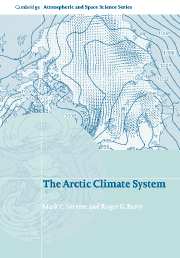Book contents
- Frontmatter
- Contents
- Preface page
- Acknowledgements
- List of Abbreviations
- 1 The evolution of knowledge about the Arctic and its climate
- 2 Physical characteristics and basic climatic features
- 3 The basic atmospheric heat budget
- 4 The atmospheric circulation
- 5 The surface energy budget
- 6 Precipitation, net precipitation and river discharge
- 7 Arctic ocean–sea ice–climate interactions
- 8 Climate regimes of the arctic
- 9 Modeling the arctic climate system
- 10 Arctic paleoclimates
- 11 Recent climate variability, trends and the future
- References
- List of selected websites
- Index
- Plate Section
11 - Recent climate variability, trends and the future
Published online by Cambridge University Press: 10 August 2009
- Frontmatter
- Contents
- Preface page
- Acknowledgements
- List of Abbreviations
- 1 The evolution of knowledge about the Arctic and its climate
- 2 Physical characteristics and basic climatic features
- 3 The basic atmospheric heat budget
- 4 The atmospheric circulation
- 5 The surface energy budget
- 6 Precipitation, net precipitation and river discharge
- 7 Arctic ocean–sea ice–climate interactions
- 8 Climate regimes of the arctic
- 9 Modeling the arctic climate system
- 10 Arctic paleoclimates
- 11 Recent climate variability, trends and the future
- References
- List of selected websites
- Index
- Plate Section
Summary
Overview
Over the period of instrumental records, the Arctic climate system has exhibited pronounced variability on interannual, decadal and multi-decadal scales. An important but by no means exclusive source of this variability is the North Atlantic Oscillation (NAO), which describes mutual strengthening and weakening of the Azores High and the Icelandic Low. More recently, considerable attention has been paid to the “Arctic Oscillation” (AO), also known as the Northern Annular Mode (NAM), which represents the leading mode of monthly sea level pressure variability poleward of 20° N. The AO has a primary center of action over the Arctic, centered near the Icelandic Low, and opposing centers of action in the Pacific and Atlantic basins. The AO can be interpreted as an oscillation of atmospheric mass between the Arctic and mid-latitudes, associated with strengthening and weakening of the circumpolar vortex. The NAO and AO are present year-round, but are best expressed in the winter season and have very similar impacts on Arctic climate. Whether the NAO and AO are different expressions of the same basic phenomenon is a matter of debate. Circulation variability associated with the NAO/AO has pronounced influences on SAT and precipitation, not only over the Atlantic side of the Arctic strongly influenced by the Icelandic Low, but extending across large areas of the northern high latitudes. The NAO/AO also has pronounced influences on the sea ice cover. Multi-decadal climate variability associated with the NAO/AO appears to involve ocean coupling.
- Type
- Chapter
- Information
- The Arctic Climate System , pp. 291 - 334Publisher: Cambridge University PressPrint publication year: 2005
- 1
- Cited by



